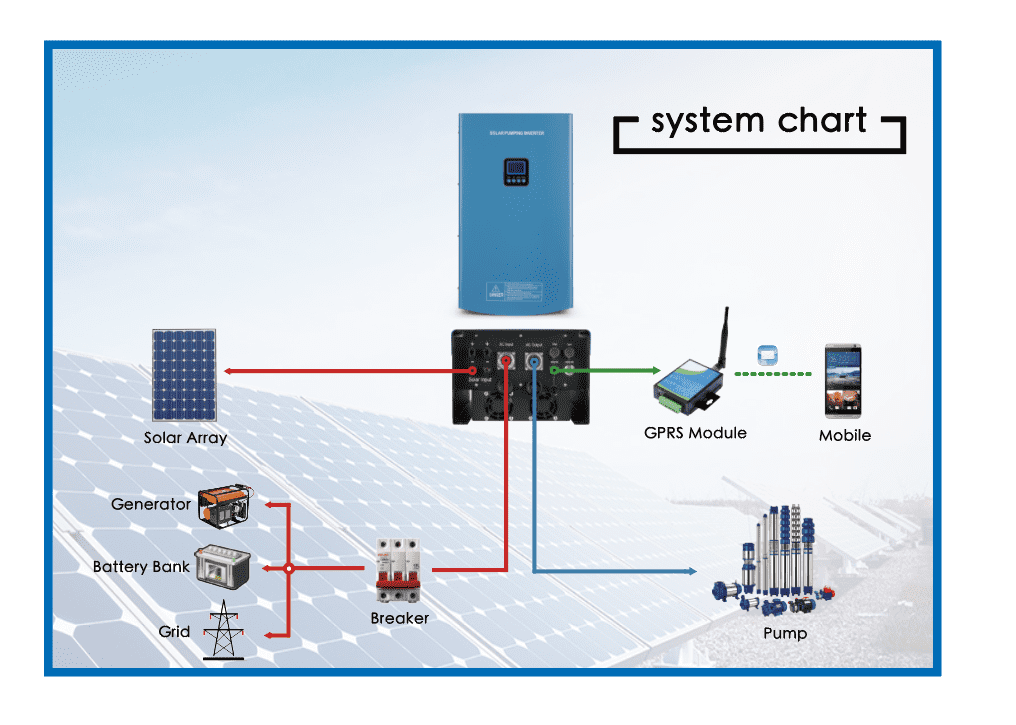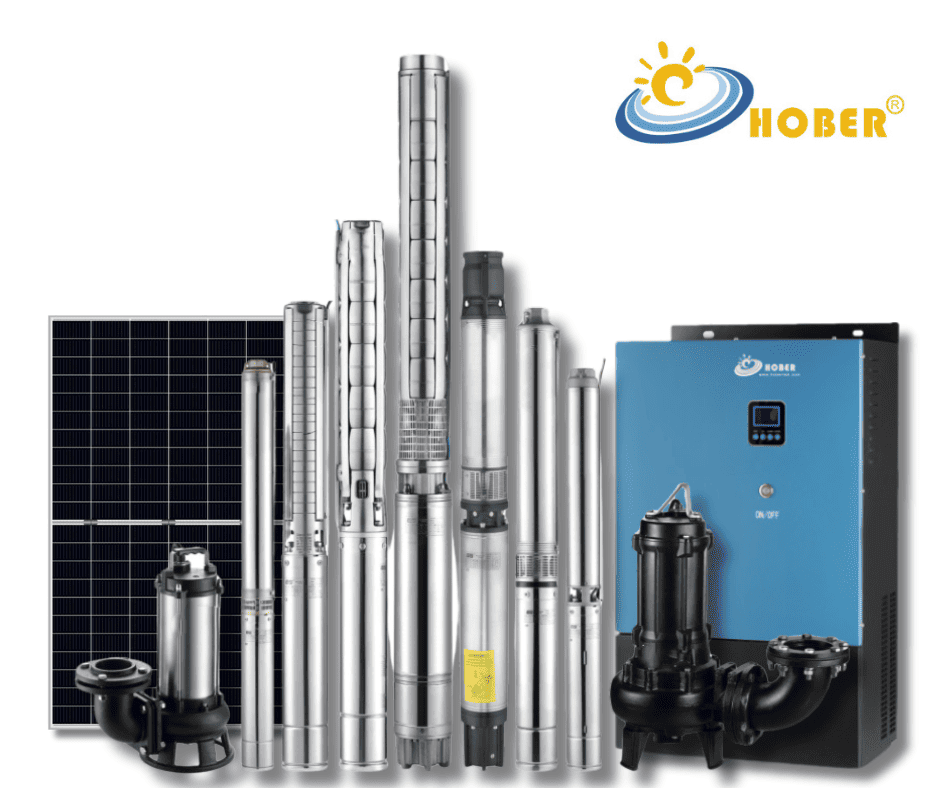Introducción
Las bombas de agua eléctricas solares representan un enfoque innovador y ecológico para la gestión del agua, proporcionando una solución sostenible para el riego, el abrevadero del ganado y el suministro comunitario de agua. Estas bombas son cada vez más eficientes y asequibles, y ofrecen importantes ahorros en las facturas de electricidad al tiempo que garantizan un funcionamiento continuo. Este artículo profundiza en la mecánica, los beneficios, las aplicaciones y las consideraciones de las bombas de agua eléctricas solares, enfatizando su capacidad para operar con entradas de energía de CA y CC para una funcionalidad las 24 horas.

Comprensión de las bombas de agua eléctricas solares
¿Qué son las bombas de agua eléctricas solares?
Las bombas de agua eléctricas solares utilizan paneles fotovoltaicos (PV) para convertir la luz solar en energía eléctrica, que acciona un motor eléctrico para bombear agua desde una fuente, como un pozo, río o embalse, hasta el lugar deseado. Estos sistemas pueden variar en complejidad, desde configuraciones simples para riego en pequeña escala hasta instalaciones sofisticadas para grandes operaciones agrícolas o suministros de agua comunitarios.
¿Cómo trabajan?
- Paneles solares: El sistema comienza con paneles solares que capturan la luz solar y la convierten en electricidad de corriente continua (CC).
- Controlador: Esta electricidad fluye hacia un controlador, que regula la energía para garantizar un rendimiento óptimo y proteger el sistema de anomalías eléctricas.
- Bomba de doble potencia: El controlador envía la potencia regulada a una bomba de doble potencia, que puede funcionar tanto con CC de los paneles solares como con CA de la red o un generador. Esto garantiza que la bomba pueda funcionar de forma continua, incluso en horas sin sol.
- Entrega de agua: La bomba mueve el agua a través de tuberías hasta el punto de uso, ya sea un tanque de almacenamiento, un sistema de riego o un abrevadero para ganado.
Beneficios de las bombas de agua eléctricas solares
1. Sostenibilidad ambiental
Las bombas de agua eléctricas solares ofrecen una alternativa ecológica a las bombas diésel o alimentadas por red. Reducen las emisiones de gases de efecto invernadero y la dependencia de los combustibles fósiles, alineándose con los esfuerzos globales para combatir el cambio climático.
2. Rentabilidad
Aunque la inversión inicial en tecnología solar puede ser alta, los costos operativos son mínimos. Las bombas solares utilizan energía gratuita del sol, lo que elimina los costos de combustible y reduce los gastos de mantenimiento debido a que tienen menos piezas móviles. La función de energía dual también permite ahorros significativos en la factura de electricidad al minimizar el uso de energía de la red.
3. Confiabilidad y operación las 24 horas
La capacidad de funcionar con entradas de energía de CA y CC garantiza que las bombas de agua solares proporcionen un suministro de agua confiable y autónomo, incluso durante los días nublados o la noche. Esta funcionalidad de 24 horas es crucial para una disponibilidad constante de agua en la agricultura, el abrevadero del ganado y los suministros de agua comunitarios.
4. Escalabilidad y flexibilidad
Estos sistemas se pueden adaptar a diferentes escalas y propósitos. Ya sea para pequeños jardines domésticos o campos agrícolas extensos, las bombas solares se pueden personalizar para satisfacer necesidades de agua específicas.
Aplicaciones de las bombas de agua eléctricas solares
1. Riego Agrícola
Las bombas de agua solares se utilizan ampliamente para el riego en la agricultura. Se pueden programar para funcionar durante las horas pico de luz solar, lo que garantiza un uso eficiente del agua y respalda prácticas agrícolas sostenibles. La capacidad de doble potencia garantiza un riego ininterrumpido.
2. Riego del ganado
Los agricultores y ganaderos utilizan bombas solares para suministrar agua al ganado, especialmente en pastos remotos. Estos sistemas reducen los costos de mano de obra y combustible asociados con el transporte de agua manualmente o el uso de bombas diésel, y la función de doble potencia garantiza un suministro continuo de agua.
3. Abastecimiento de agua comunitario
En muchas regiones en desarrollo, las bombas solares proporcionan una fuente confiable de agua potable para las comunidades, mejorando los resultados de salud y reduciendo la carga para las mujeres y los niños que a menudo viajan largas distancias para buscar agua. La capacidad de operación las 24 horas garantiza una disponibilidad constante de agua.
4. Acuicultura
Las bombas solares también se utilizan en la acuicultura para hacer circular y oxigenar el agua, mejorando las condiciones de vida de los peces y otras especies acuáticas, aumentando así la productividad y la sostenibilidad de las operaciones de piscicultura.
Características clave de las bombas de agua solares de doble potencia
1. Entrada de energía CA y CC
La característica más crítica de estas bombas de agua solares es su capacidad para funcionar con entradas de energía de CA y CC. Esta capacidad de doble potencia garantiza que la bomba pueda cambiar a la red eléctrica o a un generador cuando la luz solar sea insuficiente, lo que garantiza un funcionamiento continuo.
2. Eficiencia energética y ahorro de costes
Al utilizar principalmente energía solar y cambiar a energía de la red solo cuando es necesario, estas bombas reducen significativamente los costos de electricidad. Esta eficiencia energética se traduce en ahorros sustanciales a lo largo del tiempo, lo que los convierte en una opción económicamente atractiva.
3. Operación continua las 24 horas
La función de entrada de energía dual garantiza que la bomba pueda funcionar las 24 horas del día, proporcionando un suministro de agua confiable independientemente de las condiciones climáticas. Esto es especialmente beneficioso para aplicaciones críticas que requieren disponibilidad ininterrumpida de agua.
4. Mayor durabilidad y longevidad
Las bombas de agua eléctricas solares están diseñadas para soportar diversas condiciones ambientales. La combinación de componentes de alta calidad y menos piezas móviles reduce la necesidad de mantenimiento y reparaciones frecuentes, lo que prolonga la vida útil de la bomba.
Consideraciones para la implementación de bombas de agua eléctricas solares
1. Evaluación del sitio
Antes de instalar una bomba de agua solar, es fundamental realizar una evaluación exhaustiva del sitio. Esto incluye evaluar los niveles de insolación solar, la confiabilidad de la fuente de agua y las necesidades de agua específicas de la aplicación.
2. Dimensionamiento del sistema
El dimensionamiento adecuado del sistema de bomba solar es esencial para garantizar que satisfaga la demanda de agua de manera eficiente. Se trata de calcular las necesidades diarias de agua y compararlas con el potencial de energía solar y la capacidad de la bomba.
3. Inversión Inicial y Financiamiento
Si bien las bombas de agua solares pueden ahorrar dinero a largo plazo, la inversión inicial puede ser sustancial. Los usuarios potenciales deben explorar opciones de financiación, subsidios y subvenciones disponibles para proyectos de energía renovable.
4. Mantenimiento y soporte
Aunque las bombas solares requieren menos mantenimiento que las bombas convencionales, son necesarios controles y mantenimiento periódicos para garantizar la longevidad y la eficiencia. Tener acceso a soporte técnico y repuestos también es vital.
Conclusión
Las bombas de agua eléctricas solares con capacidad de entrada de energía dual cambian las reglas del juego en la gestión sostenible del agua. Ofrecen numerosos beneficios ambientales, económicos y sociales, lo que los convierte en una opción inteligente para diversas aplicaciones, desde la agricultura hasta el suministro comunitario de agua. Al aprovechar la energía del sol y garantizar un funcionamiento las 24 horas a través de entradas de CA y CC, estas bombas proporcionan una solución confiable y rentable para los desafíos actuales del agua. A medida que la tecnología siga evolucionando, es probable que estos sistemas se vuelvan aún más eficientes y accesibles, impulsando la transición hacia un futuro más sostenible y resiliente.

